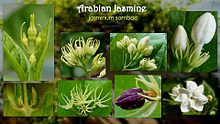| Jasminum sambac | |
|---|---|

| |
| A 'Maid of Orleans' cultivar from Tunisia | |

| |
| Various flower stages | |
| Scientific classification | |
| Kingdom: | Plantae |
| Clade: | Tracheophytes |
| Clade: | Angiosperms |
| Clade: | Eudicots |
| Clade: | Asterids |
| Order: | Lamiales |
| Family: | Oleaceae |
| Genus: | Jasminum |
| Species: | J. sambac
|
| Binomial name | |
| Jasminum sambac | |
| Synonyms[1][2] | |
| |
Jasminum sambac (Arabian jasmine or Sambac jasmine)[1][3] is a species of jasmine with a native range from Bhutan to India[4][5] It is cultivated in many places, especially West Asia, South Asia and Southeast Asia. It is naturalised in many scattered locales: Mauritius, Madagascar, the Maldives, Christmas Island, Chiapas, Central America, southern Florida, the Bahamas, Cuba, Hispaniola, Jamaica, Puerto Rico, and the Lesser Antilles.[6][7][8]
Jasminum sambac is a small shrub or vine growing up to 0.5 to 3 m (1.6 to 9.8 ft) in height. It is widely cultivated for its attractive and sweetly fragrant flowers. The flowers may be used as a fragrant ingredient in perfumes and jasmine tea. It is the national flower of the Philippines, where it is known as sampaguita,[9] as well as being one of the three national flowers of Indonesia, where it is known as melati putih.
- ^ a b "Jasminum sambac (L.) Aiton". Germplasm Resources Information Network. Agricultural Research Service, United States Department of Agriculture. Retrieved 8 March 2011.
- ^ Ginés López González (2006). Los árboles y arbustos de la Península Ibérica e Islas Baleares: especies silvestres y las principales cultivadas (in Spanish) (2 ed.). Mundi-Prensa Libros. p. 1295. ISBN 978-84-8476-272-0.
- ^ "Jasminum sambac (L.) Aiton, Oleaceae". Pacific Island Ecosystems at Risk (PIER). 18 October 2006. Retrieved 8 May 2011.
- ^ https://powo.science.kew.org/taxon/urn:lsid:ipni.org:names:609755-1
- ^ Olveros-Belardo, Luz; Smith, Roger M.; Ocampo, Milagros P. (990). "Some Components of the Absolute of the Rowers of Jasminum sambac (l.) Ait" (PDF). Transactions of the National Academy of Science and Technology. 12 (6): 129–140.
- ^ Cite error: The named reference
sanchezwas invoked but never defined (see the help page). - ^ "Plants of the World Online | Kew Science". Plants of the World Online.
- ^ "Biota of North America Program".
- ^ Pangilinan Jr., Leon (3 October 2014). "In Focus: 9 Facts You May Not Know About Philippine National Symbols". National Commission for Culture and the Arts. Archived from the original on 26 November 2016. Retrieved 8 January 2019.